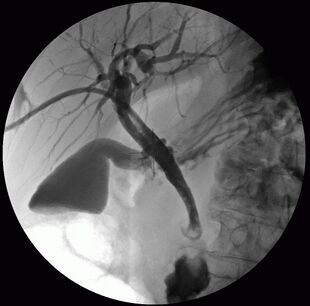Medicine:Cholangiography
From HandWiki
Cholangiography is the imaging of the bile duct (also known as the biliary tree) by x-rays and an injection of contrast medium.[1]
Types
There are at least four types of cholangiography:[citation needed]
- Percutaneous transhepatic cholangiography (PTC): Examination of liver and bile ducts by x-rays. This is accomplished by the insertion of a thin needle into the liver carrying a contrast medium to help to see blockage in liver and bile ducts.
- Endoscopic retrograde cholangiopancreatography (ERCP). Although this is a form of imaging, it is both diagnostic and therapeutic, and is often classified with surgeries rather than with imaging.
- Primary cholangiography (or perioperative): Done in the operation room during a biliary drainage intervention.
- Secondary cholangiography: Done after a biliary drainage intervention.
In both cases fluorescent fluids are used to create contrasts that make the diagnosis possible. Cholangiography has largely replaced the previously used method of intravenous cholangiography (IVC).[citation needed]
- Magnetic resonance cholangiopancreatography (MRCP) is another cholangiography method.
References
 |


